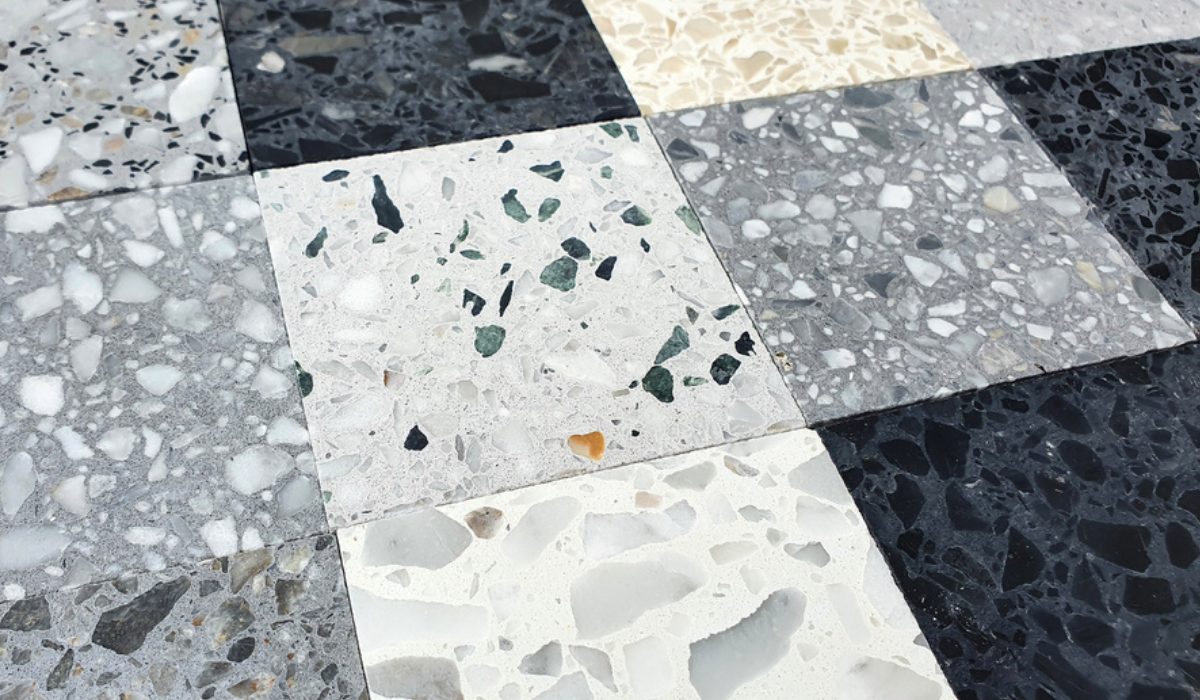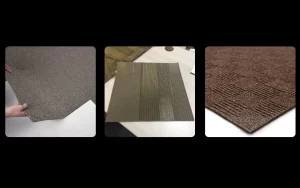- Introduction
- What is Terrazzo Flooring?
- Types of Terrazzo Flooring
- Traditional Terrazzo
- Modern Terrazzo Variants
- Comparison with Other Flooring Types
- Where Should You Use Terrazzo Flooring?
- Residential Applications
- Commercial and Industrial Applications
- Outdoor Uses
- Benefits of Terrazzo Flooring
- Sustainability
- Design Flexibility
- Durability and Longevity
- Disadvantages of Terrazzo Flooring
- Cold and Hard Surface
- Complexity In Installation
- Cost
- Cost Factors for Terrazzo Flooring
- Maintenance and Care Tips for Terrazzo Flooring
- Stain Removal
- Routine Cleaning
- Long Term Maintenance
- How to Install Terrazzo Flooring
- Step 1: Preparation of Surface
- Step 2: Installation of Divider Strips
- Step 3: Mixing and Pouring of Terrazzo
- Step 4: Grinding and Polishing
- Step 5: Finishing Touches
- Professional vs DIY Installation
- Conclusion
- FAQs
Table Of Content
Introduction
Looking for low-maintenance and stylish flooring for your home or office? No need to look further; terrazzo flooring gives a stylish and durable look to your place. To your interest, you can use terrazzo flooring for the base, countertops, flooring, walls, etc. Furthermore, the durability and endless customization options make it a perfect choice for residential and commercial places.
Let’s get to know about the maintenance tips, installation process, advantages, and drawbacks of terrazzo flooring before making any flooring decision.
What is Terrazzo Flooring?

In simple words, terrazzo flooring is the marble, granite, glass, or shell chips, which are set in cement or epoxy matrix binder to make your ground stylish. To your surprise, Terrazzo flooring has a history, from Egyptian mosaic to Venice, dating back to around the 15th century. In search of cost-effective techniques, Venetian construction workers find the practical solution to use the discarded marble scraps to form beautiful, durable surfaces. Hence, from the 16th century, terrazzo became popular in public buildings and villas due to its appealing designs and vibrant colours. Now, in the modern world, terrazzo consists of resin, polymers, and epoxy to increase its texture and durability.
Types of Terrazzo Flooring
With multiple types, Terrazzo flooring comes with specific characteristics and applications that make our flooring ground smooth and polished. Let’s have a look.
Traditional Terrazzo
Traditional terrazzo is made from marble chips mixed with Portland cement. This classic style is known for its durability and is often found in high-traffic areas like schools, hospitals, and commercial buildings. However, the installation of traditional terrazzo is quite intensive, and you need a skilled craftsman for the seamless finish.
Modern Terrazzo Variants
For lighter, thin, and flexible flooring in modern terrazzo styles, you will see options like epoxy terrazzo, which uses epoxy resin as the binder instead of cement. Moreover, this type of flooring offers a multiple colour range and chemical resistance, which makes it a more popular choice for commercial settings. However, be mindful that it is not ideal for outdoor use as it can fade and peel.
Note: If you are a resident of Edmonton and searching for best flooring store, you are on a right track. we are the leading choice among flooring stores in Edmonton. Visit our showroom today and discover why we are the leading Edmonton flooring store.
Comparison with Other Flooring Types
No doubt, there are multiple flooring options available in the market, like tiles and hardwood floors, to give a new and balanced look. In the case of Hardwood floors, they look great, but they need more care and can get scratched easily. The same is true for tiles, which crack easily and come in limited designs only. However, terrazzo flooring has unique customization and design options, which makes it different. Although terrazzo may cost more initially, it is a low-maintenance flooring option. Its durability and long-lasting option work like magic in homes and businesses.
Where Should You Use Terrazzo Flooring?
Terrazzo flooring is a fantastic choice for your home and in commercial and outdoor settings. Let’s have a look.
Residential Applications
In residential spaces, and especially in kitchen, bathroom, and living space, terrazzo should be your first priority. In the kitchen, the most used part of our homes, where there is a lot of foot traffic, the durability of terrazzo makes it the perfect choice for flooring. You can choose unique terrazzo designs for your living space to make it more elegant. Even in the bathroom, it resists moisture and gives a stylish look with multiple customization options.
Commercial and Industrial Applications
There is no better choice for your commercial spaces than Terrazzo, such as offices, retail stores, and hospitals. Its durability and easy maintenance make it ideal for high-traffic areas. Plus, the wide range of design options helps businesses to choose according to their brand specifications. Mostly in Hospitals, terrazzo is preferred because of its hygienic properties, as it’s easy to clean and resistant to stains.
Outdoor Uses
While terrazzo is often used indoors, it can also work well in outdoor settings like patios and pathways. However, it’s important to consider the type of terrazzo you choose; cement terrazzo is heavier and better suited for outdoor use than resin terrazzo, which may not hold up as well in the elements.
Benefits of Terrazzo Flooring
Sustainability
For sustainability and an eco-friendly environment, terrazzo should be your number one priority.
Nowadays, many terrazzo products use recycled materials like glass and stone. These materials help you to reduce waste from the surrounding area. Hence, by using terrazzo, especially with its recycled content, you can earn points toward LEED certification. In this way, you cannot only make your floor good but also contribute to healthier and eco-friendly conditions.
Design Flexibility
You can choose any colour, design, or pattern to customise your space flooring. Terrazzo flooring gives multiple options in flooring schemes, from subtle to multicoloured designs. Whether you prefer a classic look with marble chips or a bold design featuring colourful glass, terrazzo can be customised to match your style.
Durability and Longevity
If your terrazzo is properly installed, it can give you even 100 years of longevity. This is because of marble chips, cement, and epoxy binders, which make it durable for a longer time. Moreover, its resistant nature will save you from regular replacements or repairs, which makes it a smart choice for your residential or commercial space.
Disadvantages of Terrazzo Flooring
While terrazzo flooring has many advantages, it’s important to consider some potential downsides before making your choice.
Cold and Hard Surface
One drawback of terrazzo is that you can feel cold and hard underfoot, which might not be a comfortable option for everyone. If you enjoy walking around barefoot, you may find it a bit uncomfortable, especially in colder months. Furthermore, terrazzo does not have a cushioning factor, which is more common among soft flooring options.
Complexity In Installation
You need a required skilled professional to install flooring, as it is not easy. It involves the grinding, pouring terrazzo mixture, subfloor preparation, and polishing. The process is complex, and any mistakes could lead to costly repairs. So, be prepared to hire an experienced installer to get the best results.
Cost
One of the potential downsides of terrazzo is its cost. Even in the traditional flooring installation, it will cost you around $9 per square foot and even higher in complex designs and colours. Remember, It is a fact that the installation of terrazzo involves labour requirements and specific machinery, which makes it more expensive than other flooring options.
Cost Factors for Terrazzo Flooring
The initial installation costs for terrazzo flooring can be high. Typically, you might expect to pay between $9 and $35 per square foot. But there is no need to worry; it depends on materials, labour, and design complexity. With proper care, you can make it last longer, even for decades. It will directly reduce the need for frequent replacements and repairs, which will help you save money over time.
Maintenance and Care Tips for Terrazzo Flooring
Stain Removal
Stains can damage the floor in the long run and need to be removed quickly. You are advised to use a mild detergent or a mixture of baking soda and water to gently scrub the area.
Routine Cleaning
It is important to do the regular cleaning to remove any dust or debris from the floor. For this, you can use a damp mop with a pH-neutral cleaner to avoid damaging the surface.
Long Term Maintenance
If you want to keep your floor shining for years, use options like polishing. It will make your floor fresh and new for a longer period of time.
How to Install Terrazzo Flooring
Step 1: Preparation of Surface
To install the flooring, it is important to ensure that the subfloor is clean and dry. If there is any debris, remove it. In case of any cracks, you can check the floor. If you find any of them, fill those cracks to create a smooth base.
Step 2: Installation of Divider Strips
After preparing the surface, install divider strips on the subfloor to create a grid pattern or to control cracking. These strips will allow for different colours or designs in your terrazzo.
Step 3: Mixing and Pouring of Terrazzo
Now it’s time to mix your terrazzo. Mix the cement, aggregates, and any material according to the given instructions. After mixing, pour it on the surface, but make sure to spread it evenly; you can use a trowel for this.
Step 4: Grinding and Polishing
Leave the terrazzo for a few days to curate; it’s time to grind and polish. It is recommended to use a heavy grinder for smooth surfacing.
Step 5: Finishing Touches
Finally, apply a sealant to protect your floor from stains and moisture. Furthermore, you are advised to follow the manufacturer’s instructions for the best results.
Professional vs DIY Installation
If you have experience in flooring projects or the design is simple, you might attempt a DIY installation by following the above steps. However, for complex designs or large areas, you are suggested to hire a professional to ensure a smooth finish.
Conclusion
If you want a flooring option that is beautiful, strong, and good for the planet, consider terrazzo for your next project. Its customization, style, and durability can increase the beauty of your floor and make it a wonderful choice for your home or business.
Frequently Asked Questions
1. Can I install terrazzo flooring myself? [+]
Yes, it is possible for you to install terrazzo yourself, but it is suggested you hire a professional for the installation. The process is complex, and professionals have the right tools and experience.
2. Is terrazzo flooring expensive? [+]
Yes, terrazzo usually costs between $12.77 and $30 per square foot. It is more expensive than other flooring options, such as laminate or vinyl.
3. How to clean terrazzo flooring? [+]
To clean terrazzo flooring, you can sweep or vacuum it. However, make sure to avoid using any hard materials during the cleaning process.
4. How long does terrazzo flooring last? [+]
Terrazzo flooring is very durable and can last for many decades, even up to 100 years with proper care.








